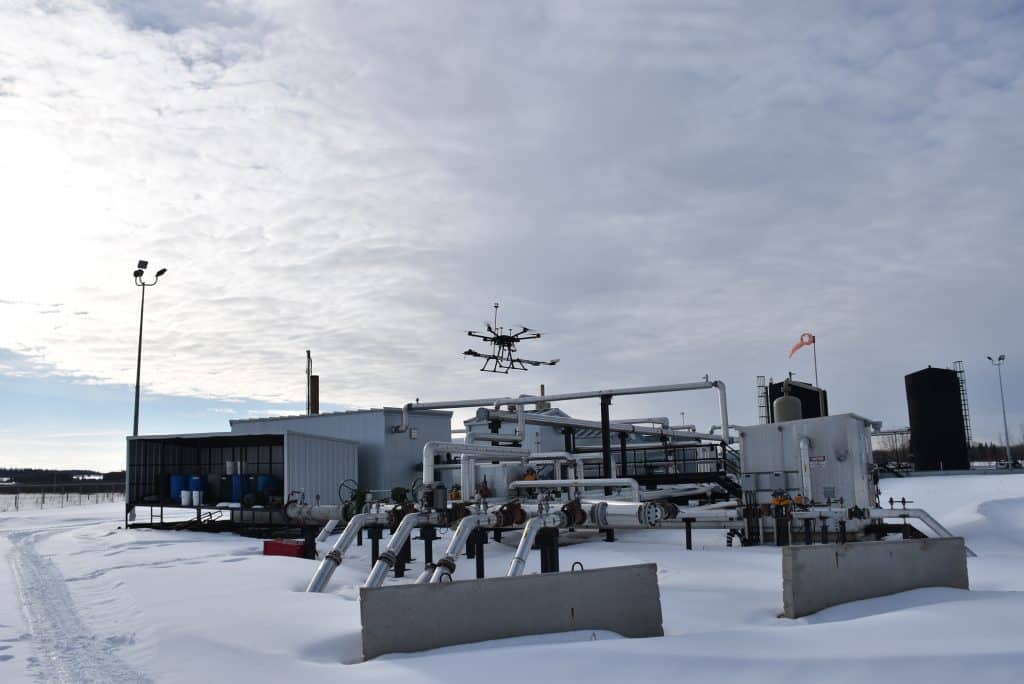What are fugitive emissions?
Typically, the term fugitive emissions relates to leaks in oil and gas storage and transportation infrastructure which allow methane gas to escape.
Globally, the reduction of methane escaping from both anthropogenic (caused by human activity) and natural sources has become a critical aspect of reducing GHG emissions. A bi-product of the oil and gas industry, methane is 25 times more potent than carbon dioxide at trapping heat in the atmosphere. Alberta was the first regional government in North America to commit to a methane emissions reduction target for the oil and gas sector of 45 per cent by 2025.
Unlike an oil leak where escaping liquids are visible, a gas leak is invisible and can be harder to spot. A drone program at The Southern Alberta Institute of Technology (SAIT) aims to provide a solution to the challenge of identifying leaks.
Drone research has been underway at SAIT for about ten years, originally by faculty from the School of Construction and the School of Transportation, and now through their Centre for Innovation and Research in Unmanned Systems (CIRUS).
We spoke with Ken Whitehead, scientific lead at CIRUS to ask about the work being done to explore the potential for methane gas detection using drones.
“Drones are used as a vehicle to carry a methane detector sensor,” said Whitehead. “Although the sensors will work equally well if mounted in a fixed position, on a vehicle or on a manned aircraft, drones have the mobility to provide access to facilities or pipelines from different altitudes and angles which would otherwise not be possible. They have the capability to provide more sensitive measurements at closer proximity, and more cost-effectively.”
Whitehead explained that there are a variety of different sensors available. Sensors that CIRUS has worked with include:
- The Open Path Laser Sensor (OPLS) was originally developed at NASA’s Jet Propulsion Laboratory for use on the Curiosity Mars Rover, but the CIRUS team took it and developed a means for mounting it on a drone. They carried out a number of tests at a facility identified by the Alberta Energy Regulator (AER) as being known to have problems. The sensor was able to identify the major methane leaks, as well as several smaller, previously unidentified ones. The OPLS is an example of a sniffer type detector, where the sensor has to be located in the methane plume in order to register methane concentrations. It uses an internal laser, tuned to a specific frequency to detect methane. The presence of methane will cause the intensity of the laser to drop.
- Swiss company Pergam has developed a system that uses a laser beam which is reflected off a specific target, such as the ground. The presence of methane anywhere between the laser and the target attenuates the reflected signal and indicates that gas is present. The advantage of this system is that the sensor does not have to be located in the methane plume.
“The Pergam system is well suited for providing a quick overview to see whether there are any leaks that need to be investigated, while the OPLS is more effective in providing a detailed analysis and quantification of leaks, once there is known to be a problem,” said Whitehead.
There are several other sensors which can be used for detecting methane, most of which use some form of lasers.
The original SAIT project was completed three years ago and the results demonstrated the great potential for methane detection using drones in oil and gas facilities. A later project, conducted with NYSearch, an organization representing municipal gas utilities throughout North America, confirmed those findings.
Reducing methane emissions represents a significant step toward our industry goal of net zero, and it is an important part of our overall emissions reduction strategy. Projects such as SAIT’s drone program can play an important role as a technology test bed, helping to identify processes and technologies offering the best potential.




